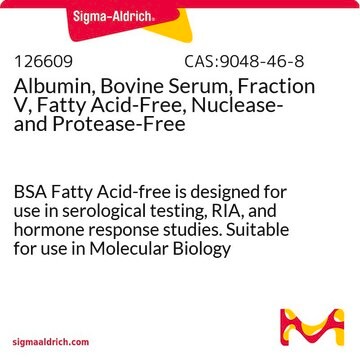B6917
Bovine Serum Albumin
lyophilized powder, suitable for (for molecular biology), Non-acetylated
Synonym(s):
Albumin bovine serum, BSA, Bovine albumin
About This Item
Recommended Products
biological source
bovine
grade
for molecular biology
Assay
≥98% (agarose gel electrophoresis)
form
lyophilized powder
quality
deacetylated
mol wt
~66 kDa
purified by
heat shock fractionation
packaging
glass bottle of
origin
USA origin
technique(s)
electrophoresis: suitable-98% using Agarose
impurities
enzymatic impurity, none detected
pH
7
solubility
water: soluble (50 mg/ml)
suitability
suitable for (for molecular biology)
UniProt accession no.
foreign activity
Alkaline Phosphatase free
Alkaline phosphatase and peroxidase, none detected
DNase free
DNase, RNase, and protease, none detected
Peroxidase free
Protease free
RNase free
storage temp.
2-8°C
Gene Information
bovine ... ALB(280717)
Looking for similar products? Visit Product Comparison Guide
General description
Application
- as a component of phosphate buffer saline (PBS) solution for dissolving tumor necrosis factor α (TNFα), which was added as a supplement for culture media
- as a blocking agent to reduce non-specific binding during the albumin sensor assay
- as a blocking agent in the immunofluorescence (IF) assay
- as a protein standard in the Bradford assay
Biochem/physiol Actions
Features and Benefits
* Alkaline Phosphatase-free
* DNase-free / Exonuclease-free
* Nickase-free / Endonuclease-free
* Peroxidase-free
* Protease-free
* RNase-free
Preparation Note
Storage Class Code
11 - Combustible Solids
WGK
WGK 1
Flash Point(F)
Not applicable
Flash Point(C)
Not applicable
Personal Protective Equipment
Certificates of Analysis (COA)
Search for Certificates of Analysis (COA) by entering the products Lot/Batch Number. Lot and Batch Numbers can be found on a product’s label following the words ‘Lot’ or ‘Batch’.
Already Own This Product?
Find documentation for the products that you have recently purchased in the Document Library.
Customers Also Viewed
Our team of scientists has experience in all areas of research including Life Science, Material Science, Chemical Synthesis, Chromatography, Analytical and many others.
Contact Technical Service




